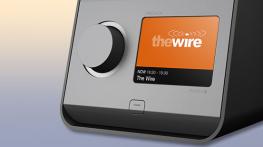
#CBAAconf: Digitising Radio
Around 50 representatives from metro, sub metro and regional stations gathered to learn about the establishment and development of community digital radio, hosted by Kath Letch and featuring Phillip Randall, Chair of the Digital Radio Consultative Committee, Philip Shine, Digital Radio Project Manager, and David Sice, Technical Consultant.
Phillip Randall opened the panel discussion and talked about the framework and corporate structure of the multiplexes for digital radio DAB+ and explained the shared transmitter arrangements, discussing the joint venture companies that have been set up for broadcast transmission and detailing the community broadcasters access to transmission. Randall also discussed the role of the Digital Radio Consultative Committee.
Philip Shine, outlined the current status of community digital radio in Australia and detailed the ways stations are currently using their digital services, and mentioned the different stages of development that the stations are at utilising their electronic program guide (EPG) systems.
David Sice explained the costs for digital broadcast multiplex transmission aspects are regulated through an ACCC access regime that sets pricing principles, ensures access and does not discriminate between commercial and non-commercial users.
The Government has a long standing commitment to ensure access remains affordable and unless Government funding support is maintained at existing levels, plus indexation, access would be out of reach for most community broadcasters, especially considering that, at this stage, digital services are running alongside analogue for most stations.
Shine said there is a potential shortfall of government funding from June 2016 for community digital radio, which is a key matter for discussion with government.
Shine says that metro stations are currently being asked to budget for a contribution of an amount towards digital radio costs as from 2016-17 - and that amount has to be affordable.
The metropolitan stations already cover digital content and service generation costs and, as take up of digital is now moving to significant levels, it is important that stations begin to profile a contribution to platform costs in their budgeting, just as they do for analogue.
The workshop addressed digital radio as the future of radio, noting that all media is digitising and that the digital broadcast platform was a critical element to enable free-to-air delivery to significant concurrent listeners. Sitting alongside that mainstay broadcast platform is complementary online delivery, and the importance of an multi-platform approach was agreed, with integration into hybrid devices now underway.
The key commitment is that primary services are available to listeners on a free-to-air basis as radio digitises. Analogue is not the future. The role of community broadcasting to address diversity, local culture and voices and maintain access and democratic discourse on a free-to-air basis is increasingly relevant as media digitises, and commercial models move to centralise and globalise.
The current take-up of digital radio across Australia was outlined and the strategies for digitisation, including analogue closure in some countries, were discussed.
The panel answered questions from delegates about regional rollout of digital services, demographics of digital take up and station financial contributions.
In the context of the digitisation of radio more broadly, formal planning for extension of DAB+ digital radio to regional Australia has now commenced. The Government recently released a report recommending a planning committee chaired the the ACMA. The community sector is represented by Kath Letch and David Sice on that committee. It is anticipated that regional extension will commences in initial set of key locations as from the latter half of 2016. Principles guiding CBAA’s positions and submissions in relation to radio digitisation are available here.
Find out more about the CBAA Conference.
Facebook comments